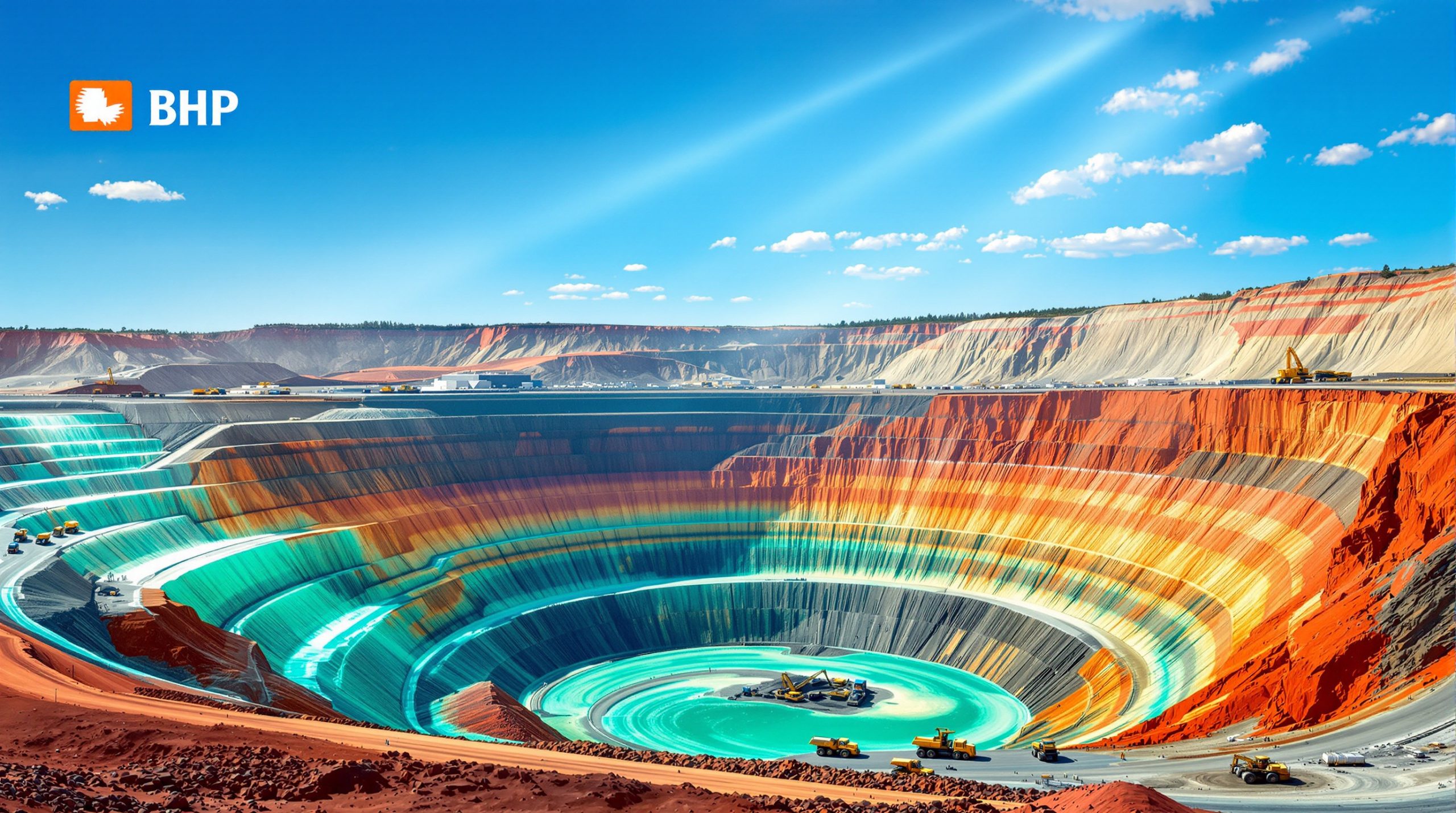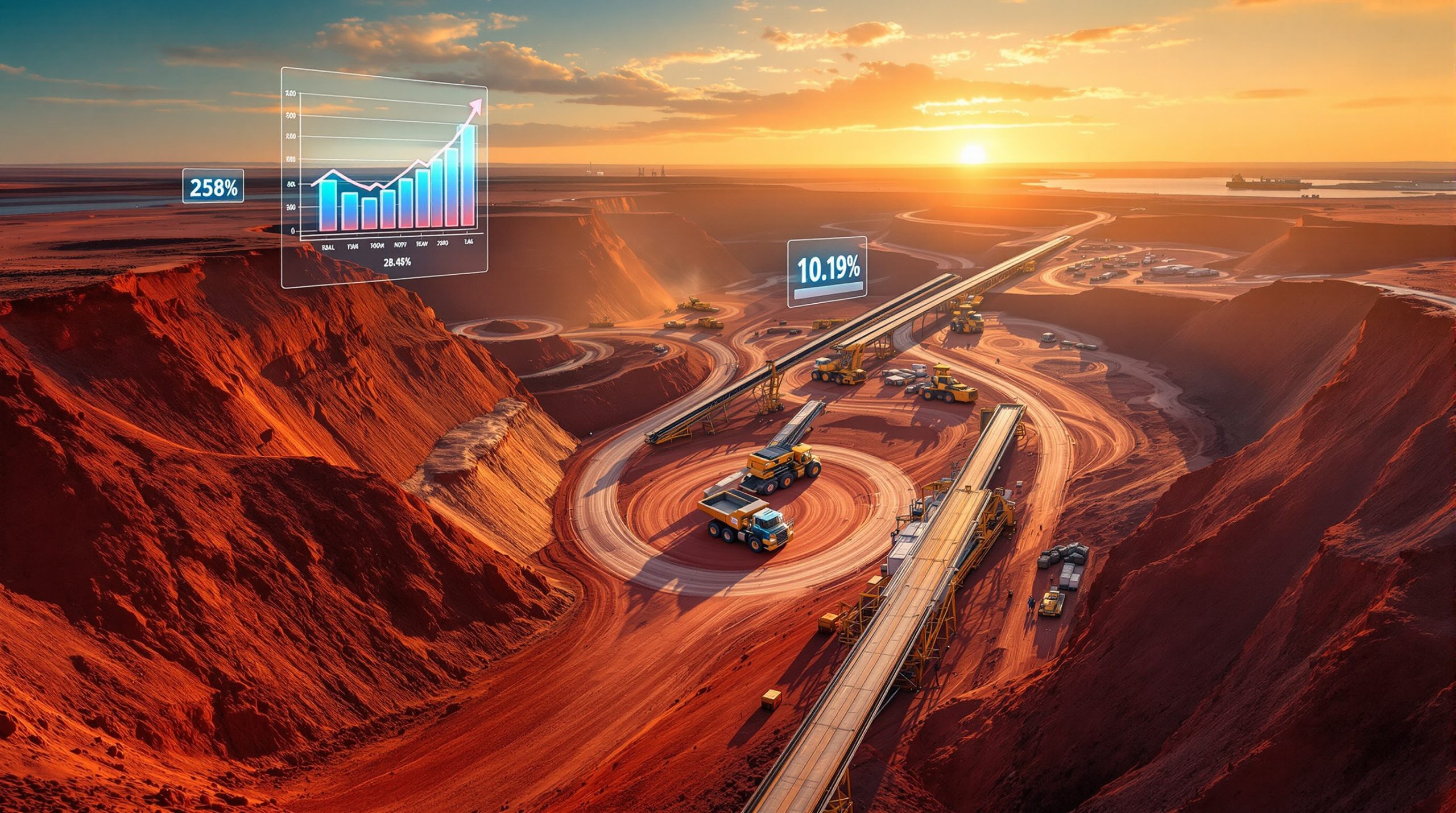Understanding the Ironback Hill Rare Earth Discovery: A Game-Changer in Australia's Critical Minerals Landscape?
Australia's mining landscape witnessed a remarkable development in 2025 with the unexpected discovery of rare earth elements at Ironback Hill. This finding has captured investors' attention and sparked discussions about its potential impact on global supply chains for these critical minerals energy security.
What is the Ironback Hill Rare Earth Discovery?
The Unexpected Mineral Find in South Australia
Located approximately 250 kilometers northeast of Adelaide in South Australia, the Ironback Hill project was initially explored for its iron ore potential. However, the project's trajectory changed dramatically when Magnetite Mines (ASX: MGT) conducted re-testing of archived drilling samples, revealing significant rare earth element mineralization that had previously gone undetected.
The discovery highlights the evolving nature of mineral exploration, where technological advancements and changing economic conditions can transform previously overlooked resources into valuable assets. What makes this find particularly interesting is that it occurred in an area already under exploration, demonstrating how reassessment of existing data can yield surprising results.
Mining analysts note that this pattern of discovering valuable minerals in previously explored areas is becoming increasingly common as companies deploy more sophisticated drill results interpretation methods to existing sample archives.
Significance of the Clay-Hosted Rare Earth Deposit
The Ironback Hill discovery has generated substantial interest primarily because of its classification as a clay-hosted rare earth deposit. These deposits typically offer significant processing advantages compared to hard-rock alternatives that dominate the market.
Clay-hosted deposits are characterized by their shallow, near-surface mineralization, which can substantially reduce mining costs. The minerals in these formations are often more accessible through simpler extraction methods using ion-exchange processes, potentially eliminating the need for intensive crushing and grinding operations required in hard-rock mining.
This type of deposit shares geological characteristics with economically viable rare earth operations in other parts of the world, including successful projects in China and the United States. The clay-hosted nature could translate to lower capital expenditure requirements and faster development timelines if the project advances to production.
From a strategic perspective, the discovery adds diversity to Australia's critical minerals reserve, potentially strengthening the nation's position in global supply chains for these essential elements.
Why Did Magnetite Mines' Stock Price Surge 181%?
Market Reaction Analysis
The market response to Magnetite Mines' announcement was nothing short of extraordinary, with the company's stock price skyrocketing by 181% in a single trading day. This represents one of the largest single-day gains in the ASX resources sector in 2025.
Trading volumes increased dramatically, exceeding the 30-day average by more than 2000%. This surge in activity transformed the company's market capitalization, growing from approximately $30 million to over $84 million virtually overnight.
Market analysts point out that such dramatic price movements in resource stocks are typically associated with major discoveries or transformational events. The magnitude of this reaction suggests investors recognize the potential strategic importance of the rare earth findings, particularly given growing global concerns about supply chain security.
Investor Sentiment Factors
Several key factors appear to have driven the enthusiastic market response:
- Critical mineral demand growth: Global demand for rare earth elements continues to accelerate, driven by electrification trends and renewable energy expansion.
- Supply chain diversification: Western nations are actively seeking alternatives to Chinese-dominated supply chains, creating potential premium markets for non-Chinese sources.
- Government support: Australia's Critical Minerals Strategy 2023-2030 provides potential funding and regulatory support for strategically important projects.
- Company transformation potential: The discovery offers Magnetite Mines the opportunity to pivot from its traditional iron ore focus to higher-value critical minerals.
- Speculative enthusiasm: Early-stage mineral discoveries inherently carry significant speculative appeal, with investors weighing potential upside against development uncertainties.
Investment strategists caution that while the market's reaction demonstrates strong interest, it's important to distinguish between speculative enthusiasm and fundamental value creation, which will require substantial additional technical work to confirm.
What Makes Rare Earth Elements Strategically Important?
Critical Applications in Modern Technology
Rare earth elements play an indispensable role in numerous high-technology applications that underpin modern economies and defense systems:
- Electric vehicle production: Permanent magnets containing neodymium and praseodymium are essential components in efficient electric motors, with each EV requiring approximately 1-2 kg of rare earth magnets.
- Wind turbine generators: Direct-drive wind turbines can contain over 600 kg of rare earth magnets per megawatt of generating capacity.
- Defense technologies: Guidance systems, radar components, electronic countermeasures, and communication equipment rely heavily on rare earth elements.
- Consumer electronics: Smartphones, computers, and other personal devices incorporate rare earth elements in speakers, vibration motors, and display technologies.
- Medical equipment: MRI machines, surgical tools, and diagnostic equipment incorporate rare earth components.
The unique electromagnetic properties of these elements make them extraordinarily difficult to substitute with alternative materials without significant performance compromises, creating what materials scientists describe as "technological lock-in" for many critical applications.
Supply Chain Vulnerabilities
The strategic importance of rare earth elements is dramatically amplified by existing supply chain vulnerabilities:
- China currently controls approximately 85% of global rare earth processing capacity, creating a potential bottleneck for Western nations.
- Historical price volatility, including a 2011 price spike of over 750% for some elements, demonstrated the market's vulnerability to supply restrictions.
- Geopolitical tensions have heightened concerns about potential supply disruptions, prompting countries including the United States, Japan, and European Union members to classify rare earths as "critical minerals" essential to economic and national security.
- Environmental and regulatory challenges have hindered development of alternative supplies, with processing facilities facing particularly complex permitting processes.
Australia's growing role in this sector is strategically significant given its status as a politically stable jurisdiction with established mining regulations and infrastructure. The country's established mining industry innovation also positions it well to develop these resources efficiently compared to less experienced mining jurisdictions.
How Significant Are the Rare Earth Grades at Ironback Hill?
Technical Analysis of Initial Results
The preliminary testing at Ironback Hill revealed Total Rare Earth Oxide (TREO) concentrations ranging between 0.036% and 0.115%. For context, TREO represents the combined concentration of all rare earth elements present, expressed as their oxide equivalents.
Particularly noteworthy is the confirmed presence of neodymium oxide in the samples, which commands premium pricing due to its critical role in permanent magnet manufacturing. Neodymium magnets generate the strongest magnetic fields per unit volume of any known material, making them irreplaceable in many high-performance applications.
The shallow depth of mineralization enhances the extraction potential, as mining costs typically increase significantly with depth. Near-surface deposits allow for more cost-effective open-pit mining methods rather than underground operations.
Geologists familiar with rare earth exploration note that these initial grades, while not exceptional, are potentially economic for clay-hosted deposits due to their typically lower processing costs compared to hard-rock alternatives.
Comparison with Global Benchmarks
When evaluating rare earth projects, grade alone provides an incomplete picture. The economic viability depends on multiple factors:
- For clay-hosted deposits, economic viability typically begins at approximately 0.03% TREO, making Ironback Hill's preliminary results potentially significant.
- Successful operations globally operate at grades between 0.05-0.2% TREO, placing Ironback Hill's higher-grade samples within this commercially viable range.
- The specific distribution of individual rare earth elements significantly impacts value, with "magnet rare earths" like neodymium commanding substantially higher prices than more abundant elements.
- Metallurgical recovery rates—not yet established for Ironback Hill—can dramatically affect project economics regardless of in-ground grades.
For comparison, some of the world's largest clay-hosted rare earth operations in southern China operate with grades of 0.05-0.2% TREO, demonstrating that deposits with modest grades can be economically viable with the right processing methods and recovery rates.
Mining engineers emphasize that further drilling and comprehensive metallurgical testing remain essential to confirm the economic viability of the resource. The preliminary results should be viewed as encouraging but require substantial additional validation before development decisions can be made.
What Development Challenges Does Ironback Hill Face?
Technical and Economic Hurdles
Despite the promising initial results, Ironback Hill faces numerous technical and economic challenges before it could potentially advance to production:
- Metallurgical uncertainty: Recovery rates for the specific rare earth elements present have not yet been established, which could significantly impact project economics regardless of in-ground grades.
- Processing complexity: Developing an efficient, environmentally sound extraction method optimized for this specific deposit's mineralogy will require extensive testing and development.
- Capital requirements: Rare earth processing facilities typically require substantial upfront investment, with recent comparable projects requiring hundreds of millions in development capital.
- Infrastructure considerations: The project's relatively remote location may necessitate significant investment in power, water, and transportation infrastructure.
- Environmental compliance: Rare earth processing facilities must address potential concerns related to radioactive elements (thorium and uranium) commonly associated with rare earth deposits.
Mining finance specialists note that securing funding for rare earth projects has historically been challenging due to price volatility, technical complexity, and long development timelines. Projects must demonstrate robust economics across a wide range of pricing scenarios to attract investment.
Timeline Considerations
The development pathway for rare earth projects typically follows a lengthy timeline:
- Resource definition: Extensive additional drilling will be required to define the resource boundaries and establish confidence in grade continuity, typically requiring 12-24 months.
- Metallurgical testing: Comprehensive testing to optimize processing methods typically takes 12-18 months and represents a critical hurdle for project advancement.
- Feasibility studies: Preliminary economic assessments followed by more detailed feasibility studies require 12-24 months of engineering work.
- Regulatory approvals: Environmental permitting and stakeholder consultation processes average 2-3 years in South Australia for mining projects of this nature.
- Construction and commissioning: If all previous stages are successful, construction and commissioning typically require 18-30 months.
This timeline suggests that even under an accelerated development scenario, production would likely be at least 5+ years away. Mining industry observers point out that rare earth projects frequently experience delays beyond initial projections due to technical challenges and changing market conditions.
Disclaimer: The development timeline presented represents a typical industry pathway based on comparable projects. Actual development could proceed more quickly or slowly depending on technical results, regulatory processes, market conditions, and financing availability.
How Does This Discovery Compare to Other Australian Rare Earth Projects?
Competitive Landscape Analysis
Australia has emerged as a significant player in the rare earth sector, with several projects at various stages of development:
- Lynas Rare Earths (ASX: LYC) operates Mt Weld in Western Australia, Australia's only commercial rare earth mine, processing material at its facility in Malaysia. With a market capitalization exceeding $5 billion, it represents the most established Australian rare earth producer.
- Iluka Resources (ASX: ILU) is developing the Eneabba project in Western Australia, focusing on monazite processing with government funding support through a $1.25 billion loan facility.
- Australian Strategic Materials (ASX: ASM) continues advancing the Dubbo project in NSW, which contains zirconium, rare earths, niobium, and hafnium, with a distinctive "mine to manufacturer" strategy.
- Northern Minerals (ASX: NTU) operates the Browns Range pilot plant in WA, focused on heavy rare earths including dysprosium.
- Arafura Resources (ASX: ARU) is developing the Nolans project in Northern Territory, which recently secured significant offtake agreements with international partners.
Compared to these more established projects, Ironback Hill represents an early-stage discovery with potential advantages in deposit type if its clay-hosted nature is confirmed through additional testing.
Potential Market Position
Ironback Hill's potential market position within Australia's rare earth landscape could be influenced by several factors:
- Geographic diversification: Located in South Australia, the project adds regional diversity to Australia's rare earth portfolio, which is currently concentrated in Western Australia and the Northern Territory.
- Deposit type advantage: If confirmed as a viable clay-hosted deposit, Ironback Hill could potentially benefit from processing advantages compared to hard-rock operations.
- Development timeline: As a newer discovery, Ironback Hill would enter production later than more advanced projects, potentially benefiting from established supply chains and processing technologies.
- Strategic importance: South Australia's mineral development plans identify critical minerals as a priority sector, potentially offering streamlined permitting and development support.
Industry analysts note that Australia's rare earth sector is becoming increasingly crowded, suggesting that new entrants like Ironback Hill will need to demonstrate clear competitive advantages or strategic partnerships to secure necessary funding and market position.
What Are the Next Steps for Ironback Hill's Development?
Critical Path Activities
For Ironback Hill to advance from an early-stage discovery to a defined resource with development potential, several critical activities must be undertaken:
- Expanded drilling program: A comprehensive drilling campaign will be necessary to define resource boundaries, establish grade continuity, and provide samples for detailed analysis.
- Detailed metallurgical testwork: This crucial phase will determine:
- Optimal processing methods for the specific mineralogy
- Expected recovery rates for individual rare earth elements
- Presence and management of potential deleterious elements
- Preliminary process flow sheet development
- Mineral resource estimation: Following sufficient data collection, a JORC-compliant resource estimate would provide the foundation for economic assessment.
- Preliminary economic assessment: This initial economic evaluation would establish potential project viability across various scenarios.
- Environmental baseline studies: Early collection of environmental data will be essential for future permitting requirements.
Mining development specialists emphasize that the metallurgical testing phase represents the most critical technical hurdle, as many promising rare earth projects have faltered due to processing challenges despite attractive grades.
Technical Validation Requirements
The technical validation process for Ironback Hill will need to address several key areas:
- Rare earth distribution analysis: Determining the specific distribution of individual rare earth elements throughout the deposit, with particular focus on high-value elements like neodymium and praseodymium.
- Clay mineralogy assessment: Characterizing the specific clay types present will significantly impact processing method selection and effectiveness.
- Deleterious element evaluation: Identifying and quantifying potentially problematic elements, particularly thorium and uranium, which can create processing challenges and regulatory complications.
- Bulk sample testing: Moving beyond laboratory-scale testing to validate results on larger samples that better represent the deposit's variability.
- Pilot plant testing: If initial results remain promising, small-scale continuous processing trials would provide critical operational data.
Experts in rare earth processing note that each deposit has unique characteristics requiring customized processing approaches. The technical validation phase typically identifies both challenges and opportunities that weren't apparent from initial testing.
How Might This Impact Australia's Position in Global Rare Earth Supply?
Strategic Implications
The Ironback Hill discovery, if developed successfully, could contribute to Australia's growing strategic position in global rare earth supply chains:
- Australia already plays a significant role in rare earth mining through Lynas Rare Earths, but additional production would strengthen the country's position as a reliable alternative to Chinese supply.
- Western nations' critical minerals strategies explicitly identify the need for supply diversification, with Australia frequently mentioned as a preferred partner due to its political stability and established mining sector.
- The discovery aligns with Australia's Critical Minerals Strategy 2023-2030, which identifies rare earths as priority elements for development support.
- Successful development would contribute to supply security for Australia's allies, including the United States, Japan, and European Union members, all of which have formalized critical minerals partnerships with Australia.
Geopolitical analysts observe that rare earth supply has become increasingly politicized, enhancing the strategic value of new discoveries in politically stable jurisdictions like Australia.
Economic Opportunities
Beyond the direct benefits of mining operations, successful rare earth developments create opportunities for downstream value addition:
- Processing infrastructure development: South Australia could potentially host separation and processing facilities, moving beyond raw material export.
- Employment creation: Mining, processing, and supporting industries could generate hundreds of direct and indirect jobs in regional areas.
- Export revenue diversification: Rare earth exports command premium pricing compared to bulk commodities, supporting Australia's economic transition toward higher-value exports.
- Research and development investments: Processing challenges often drive innovation, with potential technology transfer to other sectors.
- Supply chain integration: Opportunities exist for collaboration with end-users in battery, magnet, and advanced manufacturing sectors.
Economic development specialists note that rare earth projects offer particularly attractive multiplier effects compared to traditional mining operations due to their technical complexity and downstream processing requirements.
What Investment Considerations Should Be Evaluated?
Risk Assessment
Investors considering exposure to the Ironback Hill discovery should carefully evaluate several risk factors:
- Early-stage uncertainty: The discovery remains preliminary, with substantial additional work required to confirm economic viability.
- Metallurgical risk: Processing performance remains the greatest technical unknown, with potential to significantly impact project economics regardless of in-ground grades.
- Market volatility: Rare earth prices have historically demonstrated extreme volatility, with some elements experiencing price swings exceeding 300% within 12-month periods.
- Financing challenges: Capital markets have shown inconsistent appetite for rare earth development funding, particularly for junior companies without established production.
- Competitive landscape: Multiple rare earth projects globally are advancing toward production, potentially creating future supply competition.
Investment analysts caution that the sharp market reaction to the announcement likely reflects speculative enthusiasm rather than proven fundamental value at this early stage of exploration.
Investment Disclaimer: This information does not constitute financial advice. All investments carry risk, and early-stage resource projects involve substantial uncertainty. Investors should conduct their own research and seek professional financial advice before making investment decisions.
Potential Catalysts
Several future developments could significantly impact Ironback Hill's prospects and valuation:
- Expanded drilling results: Additional data confirming or expanding the resource potential could provide validation of the initial findings.
- Positive metallurgical testwork: Confirmation of processing viability and favorable recovery rates would address a critical technical risk.
- Strategic partnerships: Collaborations with established rare earth processors, end-users, or government entities could accelerate development and reduce financing risk.
- Government support: Inclusion in critical minerals initiatives could provide funding, regulatory, or offtake support.
- Market recognition: Broader industry acknowledgment of the project's strategic value could attract institutional investment beyond the initial speculative interest.
Market strategists note that early-stage resource investments typically follow a "de-risking curve," with valuations potentially increasing substantially as technical and economic uncertainties are progressively addressed through systematic development work.
FAQ: Ironback Hill Rare Earth Discovery
What rare earth elements have been identified at Ironback Hill?
The initial testing has identified Total Rare Earth Oxides (TREO) including valuable neodymium oxide, which is critical for permanent magnets used in electric vehicles and wind turbines. The specific distribution of individual rare earth elements across the deposit requires further detailed analysis to determine the relative concentrations of light versus heavy rare earths.
How does clay-hosted rare earth mineralization differ from hard-rock deposits?
Clay-hosted deposits typically allow for simpler extraction methods using ion-exchange processes, potentially reducing processing costs compared to hard-rock mining which requires more intensive crushing, grinding, and chemical processing. The clay-hosted rare earths are generally found in weathered profiles where natural processes have concentrated the elements in clay minerals, making them more accessible through leaching techniques rather than high-temperature, high-pressure processing required for hard-rock sources.
What timeline might we expect for potential development?
If the project advances successfully through exploration, resource definition, metallurgical testing, and feasibility studies, development could potentially begin within 3-5 years, with production following 1-2 years after construction commencement. However, this timeline assumes favorable results at each stage of development and efficient regulatory processes, which cannot be guaranteed for any resource project.
How does this discovery impact Magnetite Mines' business strategy?
The discovery potentially transforms Magnetite Mines from a pure-play iron ore company into a diversified critical minerals developer, potentially creating multiple development pathways and revenue opportunities. This strategic diversification could reduce the company's exposure to iron ore price volatility while positioning it within the high-growth critical minerals sector, potentially attracting different investor profiles and strategic partners.
What government support might be available for this project?
The Australian government's Critical Minerals Strategy includes potential funding, regulatory support, and research assistance for projects like Ironback Hill that align with national strategic priorities for supply chain security. Specific programs include the Critical Minerals Development Program, potential loan facilities through Export Finance Australia, and research partnerships through CSIRO and other government research organizations focused on processing technology development.
Ready to Discover the Next ASX Mining Opportunity?
Stay ahead of the market with Discovery Alert's proprietary Discovery IQ model, which delivers instant alerts on significant ASX mineral discoveries like Ironback Hill, transforming complex mining data into actionable investment insights. Visit the Discovery Alert discoveries page to understand how early identification of major mineral discoveries can lead to exceptional returns.




